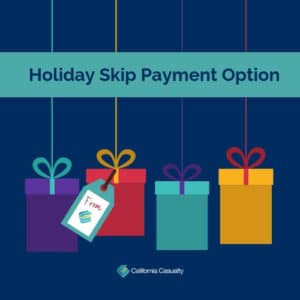by California Casualty | Auto Insurance Info |
 Make the holidays more jolly for your wallet by taking advantage of the Holiday Skip Payment option.
Make the holidays more jolly for your wallet by taking advantage of the Holiday Skip Payment option.
Don’t let your budget impact your family moments. California Casualty helps you budget for the important things in life with the Holiday Skip Payment option. You can designate the two months you’d like to free up your money during the holidays.
California Casualty’s Holiday Skip is designed to allow you enjoy the spirit of the season with family and friends without worrying about your auto insurance payments.
If you are already a customer and would like to take advantage of this unique benefit, simply go online at www.calcas.com/payments to manage your account, or contact an advisor at 1.800.800.9410.
If you’re not a customer but would like to learn more about the skip payment option and all of the other special benefits available to Educators, Firefighters, Law Enforcement Officers and Nurses, request a quote today in the Start Your Auto Quote section on the right-hand side of this page.
by California Casualty | Calcas Connection, Consider This |

Before you take to the open waters, take a moment to assess your insurance needs.
Many states do not require insurance for your boat, but most lenders and marinas do. A homeowners policy is not considered adequate for boat insurance. Homeowners insurance does not offer the coverages needed for the types of losses that occur with a boat, including salvage, wreck removal, or pollution liability. Another risk is that four-out-of-ten boaters don’t have insurance; you need to protect your family and water craft if one of them slams into you.
A boat insurance policy from California Casualty, or our partner insurer, can cover you for:
- Medical costs
- Damage to your vessel
- Wreckage removal
- Emergency towing
- Fuel spill liability
- Uninsured/underinsured boaters
TAKEAWAY: Let California Casualty help you stay afloat with the boat insurance you need. Policies vary, so it’s best to contact an advisor today at 1.877.652.2638 or [email protected].
Read all the articles from the this edition of the Calcas Connection Newsletter:
Join Our Online Community
Get Your Ride Ready For Summer
Celebrating What You Do
by California Casualty | Firefighters |
The National Volunteer Fire Council (NVFC) named Parker Ketler the 2017 Junior Firefighter of the Year at its spring board meeting April 7. California Casualty is a proud sponsor of the Junior Firefighter of the Year award and we were pleased to present Parker with his momentous achievement.
It’s easy to see why the NVFC chose him for the honor. Parker is the stepson of a firefighter and spent much of his childhood at the Sebring, Ohio Fire Department. That early exposure helped him excel when the department launched an Explorer Post in 2010. Chief Brian Anderson said that Parker was the obvious choice to become the Post’s first president.

Parker is dedicated to public safety; described as ambitious, eager and hardworking. He would often volunteer to do maintenance and other tasks at the fire station as a teen, and participated in demonstrations for other fellow students about the dangers of distracted driving.
Parker has earned several awards, including the 2016 Distinguished Volunteer Service Cross Commendation from the Village of Sebring, Alliance Elks Teen of the Month and the Award of Excellence for Sportsmanship, Ethics, and Integrity from the Ohio High School Athletic Association.
Parker continues his love for the fire service, pursuing a degree in Fire Science at Columbus State University, where he has earned his Firefighter I and II certifications and is undergoing EMT training. He has joined the Sebring Fire Department as a firefighter and serves each weekend with the department when his studies allow.
California Casualty is proud to serve firefighters, like Parker, for more than 40 years. Our company also provides funding for the NVFC Junior Firefighter Program Starter Kit, which aids fire agencies in starting their own program for their communities and to help develop future volunteer and career firefighters. Learn more about the Program at https://juniors.nvfc.org/resources.
by California Casualty | Educators |
 By Matt Davis, Freelance Contributor at Edutopia
By Matt Davis, Freelance Contributor at Edutopia
Edutopia contributor Matt Davis has collected and shares some of the best resources for parents, teachers and students to prepare for the first face-to-face meeting of the school year.
We’ve all been there; that awkward moment when parents and teachers meet for the first time to discuss the progress of their children. How can you prepare, what should you say and what’s the best course of action if there’s a problem?
From ideas for highlighting student progress, to questions every parent should ask, these are some of our favorite articles and resources that cover parent-teacher conferencing. Enjoy the rest of the school year!
- Parent-Teacher Conference Tip Sheets for Principals, Teachers, and Parents: The Harvard Family Research Project produced these tip sheets with English and Spanish versions. Each sheet has sections written specifically for parents, teachers, and principals, and is available as a free PDF download. Two other insightful resources from the Family Research Project are Academic Parent-Teacher Teams: Reorganizing Parent-Teacher Conferences Around Data and Reimagining the Parent-Teacher Conference.
- Guide to Parent-Teacher Conferences From Scholastic: This collection of resources for educators focuses on measuring student progress and conducting meaningful conferences with parents. Scholastic also features a great parent-specific resource, Make the Most of Your Teacher Conference, which offers ideas for what to do before, during, and after conferences.
- Parent-Teacher Conference Resources From Reading Rockets: This Reading Rockets article highlights literacy questions parents should ask, from suggestions for getting students reading at home to understanding your student’s reading level. There are also some great links to other Reading Rockets resources, including PTC tips for parents of English-language learners on sister site ¡Colorín Colorado!
- TeacherVision’s Parent-Teacher Conference Resources: TeacherVision hosts a wealth of resources for parent-teacher conferences. There are conference forms, curated resources for getting parents involved, and a list of some of the best articles on parent-teacher conferences. One favorite is Parent-Teacher Conferences: Before, During, and After. Another great round-up to check out is the National Education Association’s Parent-Teacher Conference page, which features practical articles and tips for parents and teachers.
- New Teacher Survival Guide Video: The Parent-Teacher Conference: This Teaching Channel video offers preparation ideas, a first-hand look at conducting a conference, and some great tips and strategies from parent-relationship expert Diane Feinstein. There are plenty of interesting tidbits packed into this ten-minute video, making it a perfect resource for educators of any experience level. Teaching Channel’s blog post, Beyond Parent-Teacher Conferences: Building Connections That Last, by Lily Jones, also provides useful advice for using conferences to springboard into continued dialogues with parents.
Inviting Students to Lead Conferences
Student-led conferences empower learners to take ownership of their accomplishments and their classroom goals. Yet, for many teachers, it can be a challenge figuring out how to best facilitate them. In 2015, Edutopia examined how one school in Chicago uses student-led conferences to create opportunities for reflection, engagement, and agency.
You’ll find some wonderful resources in that collection. Here are a few more ideas, guides, and tips for letting students take the lead during parent-teacher conferences:
Parent-Teacher Conference Reading List
The article can be found here.
by California Casualty | Educators |
They work long hours supporting and educating our children. How often have you taken the time to say thank you? Here are 25 simple ways to say thanks:
- Give a sincere thank you in person
- Slip a thank you card on their desk
- Write a special note in your child’s homework folder
- Send a kind email to thank them for something specific they did for your child
- Have your child write a note or draw a picture for them
- Stop in for a brief moment before or after school to say thanks
- Tell the principal and other administrators how much you appreciate your child’s teacher
- Send in supplies for the classroom
- Volunteer in the classroom
- Chaperone a field trip
- Volunteer to help with something at home (cutting out lamination, organizing files, etc.)
- Offer to come in and help make copies or work on a special project
- Give a gift card for Teacher Appreciation Week
- Donate an iTunes gift cards so the class can download new apps
- Buy a book to donate to the class library
- Bring in homemade treats
- Deliver a cookie, or other tasty treat from a local bakery
- Find out what their favorite snack is and bring it to them
- Recognize them with some takeout for lunch
- Make a bouquet of pencils or highlighters or other school supplies
- Compliment them on Facebook
- Bring in their favorite soft drink or tea
- Give them flowers
- Buy a gift certificate they can use at a bookstore
- Help with stress; bring a relaxing gift – bath salts, soothing lotions or gift certificate for a pedicure
Here’s another way to show appreciation for a teacher that made a difference in you or your child’s life; join the National Teachers Hall of Fame’s (NTHF) “One In A Million – Teachers Who Make A Difference” campaign. Anyone in the U.S. can place a teacher’s name into the Hall of Fame archives with a $1 donation. Donations of $125 will also get the teacher’s name placed on a brick of the NTHF donor’s wall of fame. Learn more about honoring a teacher at https://www.nthf.org/honor-an-educator.
California Casualty appreciates educators. Our relationship spans 65 years. We thank them with numerous giving programs that make a real difference:
California Casualty auto and home insurance is also specifically tailored for educator’s lifestyle with exclusive benefits not available to the general public:
- $500 personal property coverage for items stolen, damaged or destroyed in your vehicle
- Reduced or zero deductible for vandalism or damage to your vehicle when it is parked at work
- Rates guaranteed for a full year (not six months)
- Free identity theft protection with each policy
- Multiple payment options including EZ Pay and holiday or summer skips
- Superior customer service – 99 percent with a claims satisfaction rating of 96 percent, https://www.calcas.com/customer-feedback
Resources for this article:
https://whattheteacherwants.blogspot.com/2014/11/25-ways-to-thank-teacher.html
https://teaching.about.com/od/ParentalInvolvement/fl/Twenty-Five-Ways-to-Say-Thank-You-to-Teachers.htm
 Make the holidays more jolly for your wallet by taking advantage of the Holiday Skip Payment option.
Make the holidays more jolly for your wallet by taking advantage of the Holiday Skip Payment option.


 By
By